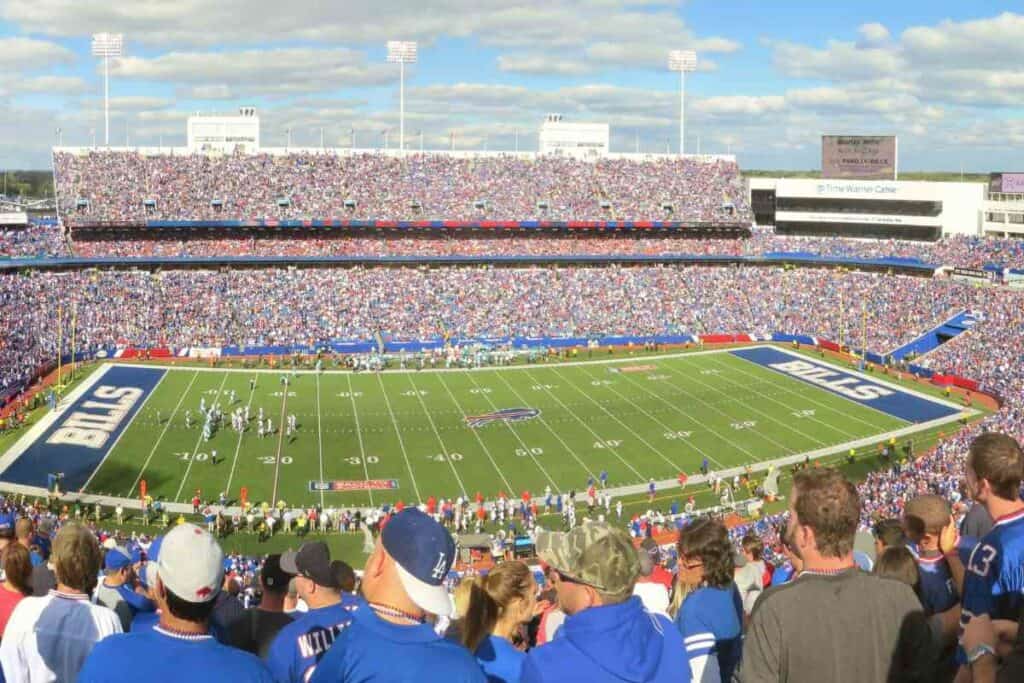NFL Quarter Length: Understanding Game Timing and Rules

The National Football League (NFL) isn’t just about the adrenaline-pumping action on the field; it’s also a dance of strategy and time management that both teams and fans need to understand. Let’s dive into how the NFL orchestrates this unique blend of sport and strategy.
Related Post! How Many Hours Are Football Games: Duration And Factors Affecting Length
How Long Are Quarters In The NFL?
In the NFL, each quarter is precisely 15 minutes long, making the total regulation time 60 minutes. However, the actual game duration often extends due to stoppages like timeouts, injuries, and strategic breaks, creating a dynamic and unpredictable viewing experience that goes beyond the clock’s simple countdown.
An NFL game is neatly packaged into four quarters, each lasting 15 minutes. But here’s where it gets interesting: the actual time spent on the field often stretches out. Why? Because of various stoppages like time-outs, injuries, and teams cleverly using the clock to their advantage.
The game’s rhythm is punctuated by breaks, including a half-time intermission and two-minute warnings at the end of the second and fourth quarters. These aren’t just pauses in the action; they’re crucial for strategic planning. Plus, let’s not forget the frequent stoppages for television commercials, which means the real-time duration of an NFL quarter can vary significantly. The average broadcast football game can extend well beyond three hours!
Key Takeaways
- NFL games are divided into four 15-minute quarters.
- The actual gameplay time is extended due to various stoppages.
- Managing the game clock is a key strategic element in NFL games.
Overview of NFL Quarter Length
When you’re watching an NFL game, you’re witnessing a battle divided into four critical periods. Each quarter is a mini-battle where teams vie for dominance.
NFL Quarter Fundamentals
Each quarter is a precise 15 minutes, making the total gameplay time 1 hour, excluding halftime, commercials, and other stoppages. The NFL’s clock management is a game within a game, with teams often using time to their strategic advantage.
- First Half: 1st and 2nd quarters
- Second Half: 3rd and 4th quarters
Unlike other levels of American football, the NFL uses a play clock to keep the game moving at a consistent pace.
Related Post! Every Football Position: A Comprehensive Guide
Comparing Different Football Levels
- NFL: 15-minute quarters
- College Football: 15-minute quarters
- High School Football: 12-minute quarters
This difference in quarter length can significantly impact the game’s pace and style, with high school games typically being shorter.

Game Structure
Understanding the structure of an NFL game, including quarter durations, halves, and overtime rules, can greatly enhance your viewing experience.
Duration of Quarters
In the NFL, each quarter is 15 minutes long, but the clock stops for various reasons, adding a layer of strategy to the game.
Halves and Halftime
An NFL game is split into two halves, each comprising two quarters. Halftime is a 12-minute break that allows teams to regroup and strategize.
Overtime Rules
In the event of a tie at the end of regulation, the game moves into overtime. Here, the first team to score a touchdown wins, but if they only manage a field goal, the other team gets a chance to score too.
Timing Rules
Understanding how the game clock and play clock operate is key to appreciating the ebb and flow of an NFL match.

Game Clock Management
The game clock is your guide through the NFL experience, tracking the real-time duration of each quarter. Remember, each quarter in the NFL spans 15 minutes of game time, but it’s not just a straightforward countdown. The clock pauses for various reasons, including incomplete passes, players stepping out of bounds, timeouts, and specific play-ending conditions.
Play Clock Operations
After the ball is ready for play, teams have a 40-second window to snap the ball, monitored by the play clock. This separate timer ensures the game keeps moving. If a team doesn’t start the play within this timeframe, they face a delay of game penalty, adding another layer of tension and strategy.
When Does the Clock Stop?
Here are the moments when the game clock takes a breather:
- Incomplete Passes: The clock stops when a pass isn’t caught.
- Out of Bounds: It pauses when a player with the ball steps or is pushed out of bounds.
- Scores: After touchdowns, field goals, and safeties, the clock stops.
- Turnovers: No time is lost during changes of possession.
- Timeouts: Each team has three per half for strategic clock stops.
- Two-Minute Warning: An automatic pause at the end of each half.
- Injuries: The clock stops when a player is injured on the field.
Additionally, the clock halts for official reviews and certain penalties, influencing the game’s pace and length.
Impact of Timing on Gameplay
Understanding the quarter length’s impact on strategy and player activity is crucial for fans and coaches alike.

Influence on Strategy
The ticking clock shapes offensive and defensive tactics. Coaches might employ a hurry-up offense when trailing, squeezing in as many plays as possible. Conversely, if leading, a team might slow down the pace, using up more of the play clock before snapping the ball, limiting the opposing team’s opportunities.
- End of Half: Teams might speed up to score or play it safe to avoid turnovers.
- End of Game: Leading teams focus on maintaining possession and running down the clock, while trailing teams aim for a rapid succession of plays.
Effect on Player Activity
Player performance is heavily influenced by the quarter timing. As the game progresses, fatigue sets in. Coaches need to manage players’ physical exertion, especially those in demanding roles. Strategic substitutions are crucial to keep up the defensive pressure and ensure players can execute plays effectively throughout the game.
- Physical Endurance: Players experience intense activity bursts followed by recovery periods.
- Strategic Substitutions: Rotating players helps maintain a high level of performance, especially on defense.
Breaks and Stoppages
In the NFL, the clock is more than just a timer – it’s a pivotal part of the game’s strategy and rhythm. Understanding how scheduled breaks and unscheduled stoppages interplay with the game’s intensity is key for both players and viewers.
Scheduled Breaks
As you immerse yourself in an NFL game, you’ll notice structured pauses that are integral to the experience. These breaks are not just for commercials; they’re crucial for players to catch their breath and for teams to strategize.
Quarter Breaks
- End of 1st Quarter: A quick 2-minute pause.
- End of 3rd Quarter: Another brief 2-minute break.
These short intervals allow for a moment of rest and quick team discussions.
Halftime Break
- Length: 12 minutes
This longer break is a critical time for teams. It’s when coaches make tactical adjustments and players recharge for the second half.

Unscheduled Stoppages
Apart from these scheduled pauses, NFL games also have unscheduled stoppages that add an unpredictable element to the viewing experience.
- Injuries: When a player is injured, the game pauses for medical attention.
- Timeouts: Each team has three 30-second timeouts per half, used strategically to stop the clock.
- Penalties: The referee’s whistle for a penalty also temporarily halts the game.
- Replays and Challenges: These stoppages vary in length and are often filled with additional commercial breaks.
These unscheduled pauses can significantly impact the game’s flow, offering unexpected twists and turns in the narrative of the match.
The Role of Stoppages in NFL Games
Both scheduled and unscheduled stoppages play a vital role in the NFL. They offer strategic opportunities for teams and provide viewers with a more dynamic and engaging experience. For players, these breaks are essential for physical and mental recovery, as well as for tactical discussions. For fans, they add suspense and depth to the game, making NFL matches not just a sport but a spectacle of strategy and endurance.
By understanding the structure and impact of these breaks, you deepen your appreciation of the game, enhancing your experience as a viewer and enriching your knowledge as a fan. The NFL’s unique blend of intense gameplay and strategic pauses creates a captivating rhythm that defines American football.
Frequently Asked Questions
In the NFL, understanding the structure of game time is crucial to fully enjoying the game.
What is the duration of each quarter in an NFL game?
Each quarter in an NFL game lasts 15 minutes, leading to a total of one hour of game time split across four quarters.
How does the NFL quarter length compare to that of college football?
Unlike the NFL’s 15-minute quarters, college football games feature the same quarter length, also set at 15 minutes per quarter.
What is the typical duration of an NFL game from start to finish?
A typical NFL game lasts approximately three hours from start to finish. This includes the playtime, stoppages, the halftime break, and any potential overtime.
How long is the halftime break in an NFL game?
The halftime break in an NFL game is set at 12 minutes, which is considerably shorter than the 20-minute halftime observed in college football.
How many total quarters are there in an NFL football game?
An NFL football game is divided into four quarters, with two quarters making up each half of the game.
What is the average amount of active play time during an NFL game?
On average, the ball is in play for about 11 minutes during an NFL game, but this can vary based on the number of stoppages and plays executed.
